A dental implant is a tiny screw, typically composed of titanium, which replaces the missing natural tooth’s root. The titanium dental implant integrates with the bone and becomes a reliable anchor for the new tooth because of its biocompatibility.
Is Dental Implant Suitable For Everyone?
Dental implants are most successful when placed in healthy individuals, although patients with medical conditions are not automatically disqualified from receiving them. Smokers have poorer success rates with dental implants, and long-term illnesses like diabetes can cause healing to be slower.
The same meticulous oral hygiene and routine dental visits that you use to take care of your natural teeth are also required for your implants.
An implant consists of the following three components, as shown below:
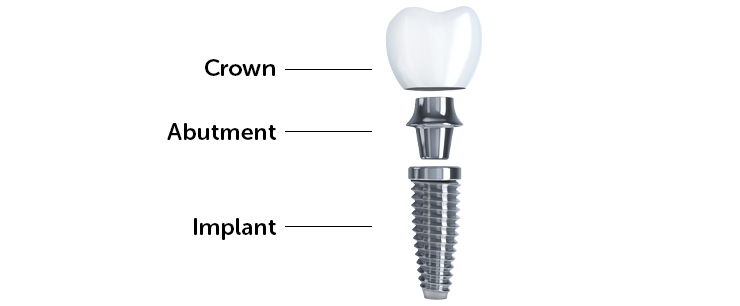
Dental Implant Scenarios
People with the following conditions may consider dental implants:
– A single tooth missing
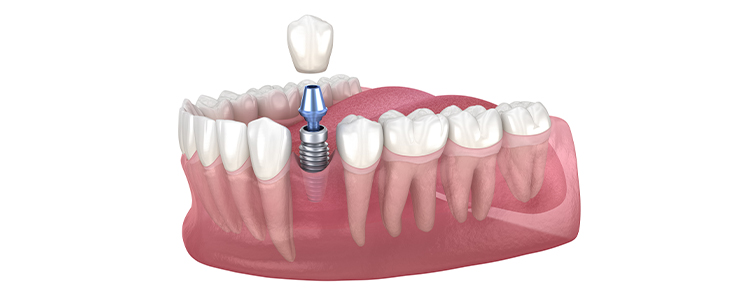
For a traditional dental bridge, the process entails crowning the teeth on either side of the gap. Dental implants do not impact the nearby teeth, in contrast to a traditional bridge.
– Several teeth missing
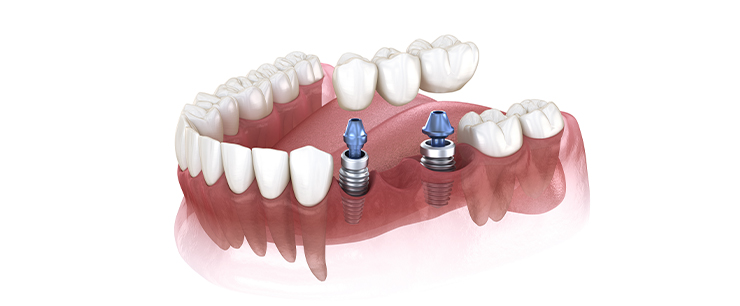
An implant bridge can be utilized to bridge the gap left by several lost teeth. Like a single implant, the implants are implanted, and then an implant bridge is placed on top of them. There is no need to crown any of the nearby teeth because the bridge is positioned from one implant to the other implant.
– All teeth missing
Option 1: Standard implants and zirconium crowns
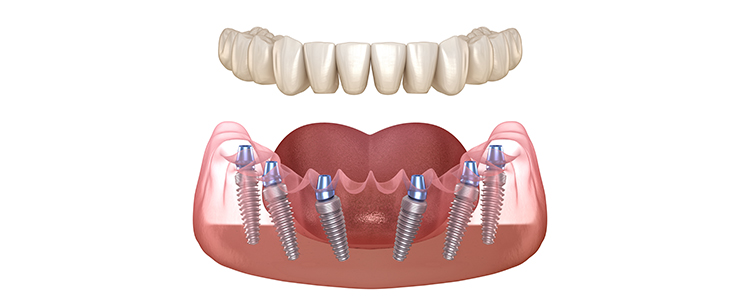
A full set of implants is advised for this option. For this, a minimum of six implants would be needed in the lower jaw and a maximum of eight implants in the upper jaw. The upper and lower jaws are then fitted with two sets of zirconium crowns.
Option 2: An acrylic cast denture with all-on system implants and a click system
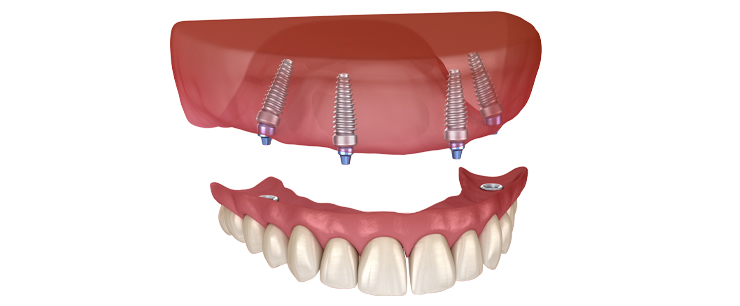
The click denture system is the second alternative, which combines implants. On the top jaw, four implants are inserted, and on the lower jaw, four implants. The implants are then covered with an acrylic cast denture using a click mechanism. Your dentures are secured in place by the denture clicking on the implants. The dentures are simple to maintain because they may be taken out without any effort.
How Do I Determine Whether I Am a Good Candidate For A Dental Implant?
If you’re thinking about getting implants, make sure you have a strong bone structure and healthy gums. These are important elements determining the implant surgery’s result and success. Before travelling abroad for implants, it is important to get an X-ray to assess your bone, gums, and teeth. This will make it easier for the dentist to give you detailed information about the therapy, including how long it will last and how much it will cost.
If a patient is taking oral or intravenous bisphosphonates, implants may not be advised because of the increased risk of osteonecrosis. Osteonecrosis is a bone condition brought on by a reduction in the blood flow to the bone.
Dental Implant Related Procedures
Bone Augmentation

Long-term tooth loss, known as jawbone resorption or bone loss, causes the strength and thickness of the jawbone to significantly decline, even if a removable denture is being worn. The only method of tooth replacement that stops bone resorption is a dental implant. However, there must be enough jawbone to successfully implant the device.
Bone augmentation is required if there is insufficient bone or if the tissue is too soft for the implant to be put in. Replacement of missing bone is known as bone augmentation. The location where the implant will be put is prepared by your dentist by placing synthetic (fake) bone there. Typically, recovery takes six to eight weeks. Implants can be inserted after the healing phase.
A Sinus Lift
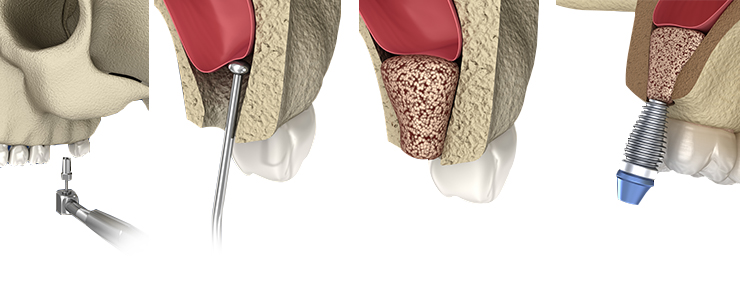
When there is not enough bone to place the dental implant firmly, sinus lifting is necessary. The upper jaw’s bone shrinks or resorbs when the upper back teeth are absent for an extended length of time. Your sinuses enlarge to fill the empty space left by the missing bone. To make room for adding more bone to that location, the sinuses must be raised. To make room for the implant, bone is inserted between your jaw and maxillary sinuses.
Dental Implant Benefits
- Dental implants mimic your original teeth in appearance and feel, and unlike dentures, they don’t cause problems when speaking or chewing, or making “clicking” noises. Additionally, they’ll restore your grin, allowing you to socialize without feeling self-conscious.
- Just like natural teeth, dental implants can be cleaned and flossed. Additionally, prosthetics over implants do not need to be taken out before bed, allowing you to go about your daily activities whenever you like.
- You won’t need to worry, unlike with dentures, as the implants are fitted to ensure that there won’t be any slippage.
- The materials used in the implants, which are commonly made of titanium, are strong and biocompatible, reducing the likelihood of injury or an allergic reaction.
- Implants, unlike bridges, do not rely on nearby teeth for support, which can help prevent further harm to healthy teeth. Additionally, since dental implants really replace the tooth and its root, bone loss is typically prevented, unlike with dentures.
- If properly cared for, dental implants are considered long-term replacements that can last a lifetime as opposed to bridges and detachable dentures, which may need to be replaced every seven to ten years.
Dental Implant Procedure
Before the Procedure
Your dentist and oral surgeon will do a thorough oral examination before the surgery. Prior to the consultation, the patient will also have an OPG (panoramic x-ray) or CT scan assessed. These are employed to determine the density of the bone where the implant or implants will be positioned. For this treatment, local anesthesia is sufficient because the only discomfort you feel is from the prick of the anesthetic needle and minor pressure.
Prior to the surgery, please remember to eat normally, drink plenty of water (non-alcoholic), skip breakfast, and take all of your medications as prescribed.
Dental Implant Procedure Phase 1
The gum tissue is opened and a canal is made deep into the bone to insert the implant using a special drill while you are under local anesthesia after your dentist confirms that your jawbone is healthy enough to support an implant.
Your dentist will determine the type and length of the implant based on the density and anatomical makeup of the bone. Following the placement of the implant in the channel, the gum is repaired with sutures or stitches. In some circumstances, your dentist might not seal the gum and instead attach an abutment to the implant directly.
If you currently wear a denture, you will keep using it during the healing phase; if not, a temporary prosthesis may be inserted. If necessary, existing dentures could be modified to fit more comfortably.
The recovery period typically lasts 3 to 6 months. The implant behaves like a normal tooth root during the healing process as it bonds to the bone. You proceed to the following stage after successful osseointegration, which is the structural bond that develops between your native jawbone and the titanium implant.
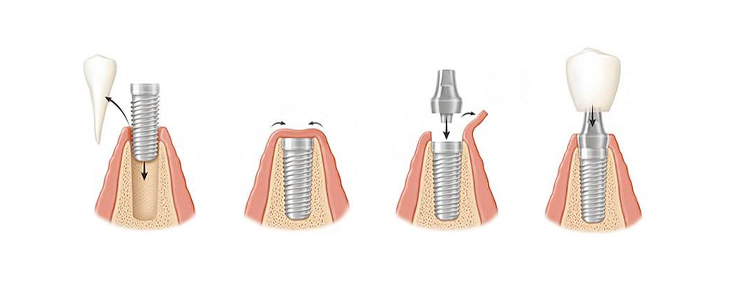
Dental Implant Procedure Phase 2
The implant is made visible by reopening the gum. Then, using specialized dental tools, an abutment is screwed and tightened to the dental implant. The abutment is then covered with a temporary crown because, in order for it to heal properly, it must be shielded from biting pressures. Until the permanent crown is prepared, the temporary crown is worn for a few days.

Following the Procedure
After-care
- For the first day, stay away from hot beverages and foods.
- Till the local anesthetic loses its effect, avoid eating.
- Avoid rubbing or touching the area with your tongue or fingers.
- If your denture covers the implant area, try to wear it as little as you can. After your operation, if the denture does not seem to fit properly, you should get it modified. A healing implant may be harmed by a poorly fitting denture.
- Stitches often last for two to three weeks before dissolving.
- Up to 48 hours after surgery, a patient should refrain from strenuous activity.
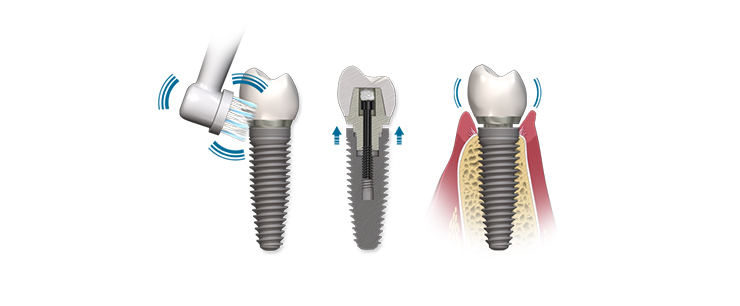
Complications
- Following surgery, moderate pain is typical for a few days, but it is manageable with painkillers. After three to four days, if the discomfort has not improved, you should make an appointment with your dentist.
- To reduce the risk of infection, you must take the antibiotics that your dentist will prescribe. The entire antibiotic course must be taken.
- Swelling is common following dental implant surgery, and it may be worse the next morning if you slept flat. The swelling can be minimized with ice packs and normally goes down after 48 hours. With 15-minute breaks, place them on the cheek for 10 minutes at a time.
- Skin bruising is possible, but it will go away in a few days.
- It’s usual for bleeding to occur after surgery. Apply pressure with a wet gauze for up to 30 minutes if it continues.
- Smoking is a significant risk factor for implant failure, thus it is crucial to quit for at least two months after the implants are placed.
- Some sensitivity may be felt after the crown or denture has been inserted. The problem can be handled by taking painkillers. After two to three days, the pain should go away.
Brands

Itinerary
If you don’t suffer from bone loss, in most cases you will need to travel to Turkey twice to finish your treatment.
1st Visit to the clinic for the insertion of dental implants
1-3 appointments 1 week
It typically takes 3 to 6 months for the implant and jawbone to fully integrate (between visits), yet in some circumstances, the prosthesis can be loaded immediately over the implants.
2nd visit (prosthesis over implants)
1 week, 3-5 appointments for zirconium bridges over conventional implants
10 days, 3-5 appointments for click system acrylic cast denture over all-on system implants
Frequently Asked Questions
What’s the difference between all-on system implants and conventional implants?
The implants serve the same function for both types of solutions, but the difference in the materials used to make the bridge over the implants significantly affects its final look, feel, and performance over time. A click system with a removable acrylic cast denture is used over allon system implants whereas fixed zirconium bridges are used over conventional implants.
Acrylic bridges with denture teeth Full arch zirconium bridges over over all-on system implants conventional implants
Much more stable and actually form
Puts stress on the supporting a supporting structure that implants resulting in bridge
Fit and function minimises any movement and stress
movement when chewing on the implants
Lifespan is much shorter. Eating
Much more durable. Withstands take a steady and gradual toll on
Durability significant pressure and resists
the acrylic resin, causing it to break chipping, fractures and wear.
down over time.
Solid. Achieve a bite and smile that is Porous (contains pores). Tend to
Appearance virtually indistinguishable from
look artificial, and stain easily. healthy, natural teeth. Doesn’t stain.
Requires more maintenance time
Maintenance i.e. removable dentures have to be Easy to clean taken out to wash
Doesn’t attract plaque and bacteria, Prone to attract plaque and
Hygiene so minimises the risk of gum disease
bacteria and bad breath (halitosis)
Full arch zirconium bridges over six
Biting force Less biting force or more conventional implants have
more biting force
Cost Cost significantly less More expensive
Is immediate loading an option for my implants?
We don’t recommend immediate loading in most cases as it is best to avoid stress on implants to let the tissues surrounding the implant heal properly to decrease the chances of failure for the treatment. If prosthesis over implants is inserted before the osteointegration completes, there will be gaps on either side of the implants increasing the chances of failure of the treatment. The risk of infection will also increase. It is best to wait a minimum of 6 to 8 weeks for the prosthesis over implants though temporary crowns can be made for the front teeth for aesthetic purposes.
Please note that any clinic that implements immediate loading will require a signed statement from you indicating that immediate loading is at your own risk.
How do dental implants help if I have full dentures or partial dentures?
Implants are most popular for patients who wear full dentures or partial dentures. They can be used to provide retention and support for a removable implant overdenture, which basically snaps on the implants eliminating dependency on denture adhesives. Dental implants can also be used for a fixed denture, where a patient’s dentures are bolted to the implants through titanium components.
TAKE ADVANTAGE OF DENTAL SAVINGS IN 5 SIMPLE STEPS
Complete The Enquiry Form Below
Fields marked * are compulsory
[wpforms id=”797″]

